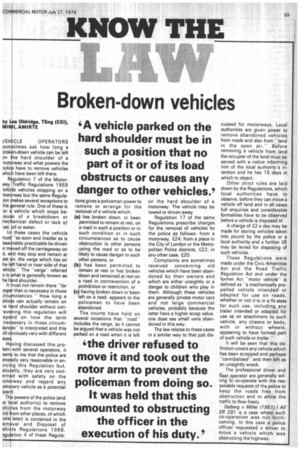Broken-down vehicles
Page 61

If you've noticed an error in this article please click here to report it so we can fix it.
by Oldridge, TEng (CEO, MI I, AMIRTE VEHICLE OPERATORS
30M times ask how long a prok n-down vehicle can be left pn he hard shoulder of a -not rway and what powers the )olic have to remove vehicles evhic have been left there.
R gulation 7 of the Motormay Traffic Regulations 1 959 • orbi s vehicles stopping on a 'not rway but the same Regula ion akes several exceptions to his eneral rule. One of these is or vehicle which stops be;au -e of a breakdown or nec anical defect or lack of uel, 11 or water.
I these cases the vehicle nus 'as soon and insofar as is eas nably practicable be driven )1. m ived off the carriageway on o, a d may stop and remain at est n, the verge which lies on he I ft hand or near side of that vhi Ie." The "verge" referred o is hat is generally known as he h rd shoulder.
It ust not remain there "for )ng than Is necessary in those irc stances." How long a ehic e can actually remain on rd shoulder without con-aye ing this regulation will ep nd on how the term necessary in those circumtances" is interpreted and this rill obviously vary with different ases.
Having discussed this prolem with several operators, it aems to me that the police are enerally very reasonable in en)rcing this Regulation but, atu ally, they are very conarned with safety on the iotorway and regard any ationary vehicle as a potential azarl.
The powers of the police (and le local authority) to remove ahicles from the motorway Ind from other places, of which tore later) is contained in the emoval and Disposal of ehitle Regulations 1968. 3gulation 4 of these Regula tions gives a policeman power to remove or arrange for the removal of a vehicle which: (a) has broken down, or been permitted to remain at rest, on a road in such a position or in such condition or in such circumstances as to cause obstruction to other persons using the road or as to be likely to cause danger to such other persons, or (b) has been permitted to remain at rest or has broken down and remained at rest on a road in contravention of a prohibition or restriction, or (c) having broken down or been left on a road, appears to the policeman to have been abandoned.
The courts have held on several occasions that ''road" includes the verge, so it cannot be argued that a vehicle was not parked on a road when it is left on the hard shoulder of a motorway. The vehicle may be towed or driven away.
Regulation 1 7 of the same Regulations prescribe charges for the removal of vehicles by the police as follows: from a motorway, £24; from a place in the City of London or the Metropolitan Police districts, £22; in any other case, £20.
Complaints are sometimes received concerning old vehicles which have been abandoned by their owners and which are either unsightly or a danger to children who play in them. Although these vehicles are generally private motor cars and not large commercial vehicles, probably because the latter have a higher scrap value, one does see small vans abandoned in this way.
The law relates to these cases in a similar way to that just dis cussed for motorways. Local authorities are given power to remove abandoned vehicles from roads and also from "land in the open air." Before removing a vehicle from land the occupier of the land must be served with a notice informing him of the local authority's intention and he has 15 days in which to object.
Other strict rules are laid down by the Regulations, which local authorities have to observe, before they can move a vehicle off land and in all cases full enquiries and considerable formalities have to be observed before a vehicle is disposed of.
A charge of £2 a day may be made for storing vehicles taken into pound by the police or a local authorit_y and a further £6 may be levied for disposing of such vehicles.
These Regulations were made under the Civic Amenities Act and the Road Traffic Regulation Act and under the former Act -motor vehicle" is defined as "a mechanically propelled vehicle intended or adapted for use on roads, whether or not it is in a fit state for such use, including any trailer intended or adapted for use as an attachment to such vehicle, any chassis or body, with or without wheels, appearing to have formed part of such vehicle or trailer."
It will be seen that this definition covers any vehicle which has been scrapped and perhaps "cannibalised" and then left as an unsightly wreck.
The professional driver and fieet operator are generally willing to co-operate with the reasonable requests of the police to keep the roads free from obstruction and to allow the traffic to flow freely.
Gelberg v Miller (1961) l ER 291 is a case where such co-operation was not forthcoming. In this case a police officer requested a driver to move a vehicle which was obstructing the highway.








































































































